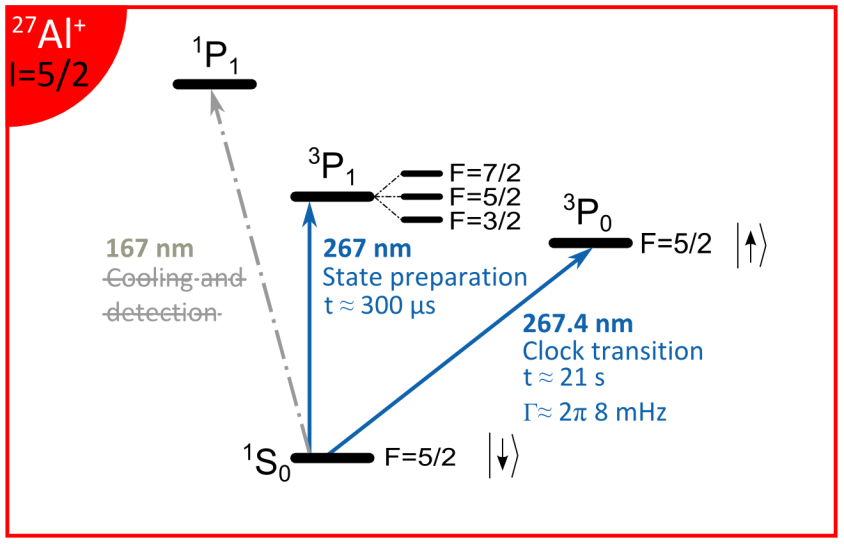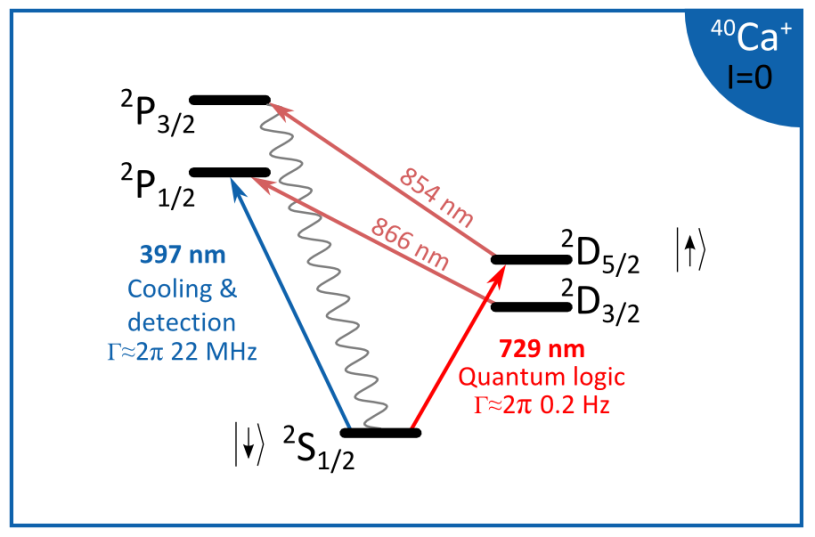27Al+ Quantum Logic Optical Clock
We are building a high-accuracy optical frequency standard based on one or more trapped 27Al+ ions, for applications ranging from fundamental physics to relativistic geodesy.
The caesium frequency standards that currently define the SI second use the microwave transition between the two hyperfine levels of the ground state of 133Cs. The frequency of this transition is approximately 9.2×109 Hz. Optical clocks, such as the one which we are developing, use electronic transitions with frequencies on the order of 1015 Hz. The five-order-of-magnitude reduction in the clock oscillation period means that small fractional frequency deviations can be detected and corrected much sooner, so optical clocks offer much better stability than microwave clocks. This stability is an important advantage in many applications. For a more detailed description of optical frequency metrology see [1].

The particular transition which we are using is a narrow (8 mHz-wide) intercombination transition at 267 nm in an 27Al+ ion confined in a linear rf Paul trap. This transition is remarkably insensitive to perturbations from external fields. Since it connects states with no electronic angular momentum, magnetic fields and electric field gradients affect it only weakly. Even better, the aluminium clock transition’s sensitivity to ambient blackbody radiation is the lowest of any known clock transition [2]. This low sensitivity to their environment has helped aluminium clocks achieve record-breaking accuracy [3].
Such high-accuracy frequency standards have a number of exciting practical and fundamental applications. For instance:
Clocks are the only instruments directly sensitive to the gravitational potential (via the Einstein shift [4]). By comparing remote clocks with 10-18 fractional uncertainty, one can measure the difference between their physical heights in Earth’s gravitational potential with centimetric accuracy. Such chronometric levelling could help to eliminate the long-range errors that accumulate in traditional optical levelling with theodolites. Mapping Earth’s gravitational potential in this way is the basis of a new field of research known as relativistic geodesy.
Many dimensionless parameters in the standard model of physics are assumed, but not known, to be constant. Two examples are the fine-structure constant α that sets the strength of the electromagnetic interaction and the ratio µ of the electron and proton masses. Because these parameters influence the transition frequencies in atoms and molecules, comparison of clocks that use different transitions with different sensitivities to these parameters can detect changes or provide an upper bound on temporal and spatial variations of these presumed constants. 27Al+ provides an accurate anchor transition that depends only very little on changes in the electromagnetic or strong interaction strength and is a useful basis for such inter-species comparisons.
Unfortunately, the dipole-allowed transition that would normally be used for laser cooling and state detection by laser-induced fluorescence is, in 27Al+, inaccessible because its 167 nm wavelength is in the VUV, beyond the range of practical laser sources. To take advantage of aluminium’s exceptional clock transition we must cool and probe the 27Al+ clock ion indirectly via a 40Ca+ logic ion, using sympathetic cooling and quantum logic spectroscopy (as described here).

Building one of the most accurate clocks in the world entails frontline research in many different areas. Some examples:
Ultra-narrowband lasers – The frequency noise of the laser used to interrogate the clock transition limits the stability of the clock, so we are building a clock laser intended to be, at timescales of a few seconds, among the most stable oscillators in the known universe.
Fast laser-cooling techniques – Because the relativistic time dilation associated with the thermal motion of the ion in the trap is a significant source of uncertainty in aluminium-ion clocks, we study novel laser-cooling techniques that allow us to operate the clock with a reduced ion temperature without adding dead time to the clock cycle.
Novel laser-locking schemes – The experiment requires light at over half-a-dozen different wavelengths. By using an optical frequency comb it is possible to phase-lock all these lasers to a single master reference, allowing coherent multi-wavelength manipulation of the ions and substantially simplifying the setup.
References
[1] Andrew D. Ludlow et al., Optical atomic clocks, Rev. Mod. Phys. 87, 637 (2015)
[2] M. S. Safronova et al., Precision Calculation of Blackbody Radiation Shifts for Optical Frequency Metrology, Phys. Rev. Lett. 107, 143006 (2011)
[3] T. Rosenband et al., Frequency ratio of Al+ and Hg+ single-ion clocks; Metrology at the 17th decimal place, Science 319, 5871 (2008)
[4] C.W: Chou et al., Optical clocks and Relativity, Science 329, 5999 (2010)
The Team
Marek Hild, Fabian Dawel, Lennart Pelzer, Nicholas Spethmann, Piet O. Schmidt
Former Members: Johannes Kramer, Nils Scharnhorst, Stephan Hannig, Ian Leroux, Sana Amairi, Jannes Wübbena
